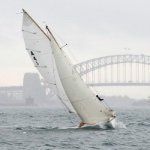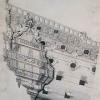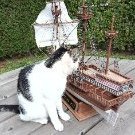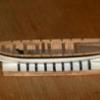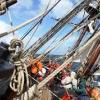-
Posts
788 -
Joined
-
Last visited
Reputation Activity
-
 Mark Pearse got a reaction from mtaylor in Australian Surf Rowing Boats
Mark Pearse got a reaction from mtaylor in Australian Surf Rowing Boats
I was prompted to post this as our daughter has just taken up the chaotic & wonderful sport of surf boat rowing. The boats are unusual & interesting, & I'm not sure if the sport is done in other countries. The shape of the boats has become quite particular, to suit rowing out through the surf, round a buoy & back to the beach. It's pretty common for 30-40% of the boats to not finish a race & sometimes worse.
The original boats were descended from double ended life boats, & during the 20C became the shape they are now, & even in the 1960s were used to rescue people. These days it is a sport only, as jet skis & surf rescue boards have taken over the rescue part.
The boats have a very short & flared bow so they don't nose dive on a wave, & long tapering hulls & a lot of rocker. I imagine most people on the forum are interested in unusual craft, so here's one more. The still photo below shows the hull shape well, & something about what the boats are for, the video shows the fun & chaos of the sport. Incredibly, less people get injured than you would think....it gets pretty wild.
summer wishes everyone!
-
 Mark Pearse got a reaction from Rik Thistle in Australian Surf Rowing Boats
Mark Pearse got a reaction from Rik Thistle in Australian Surf Rowing Boats
I was prompted to post this as our daughter has just taken up the chaotic & wonderful sport of surf boat rowing. The boats are unusual & interesting, & I'm not sure if the sport is done in other countries. The shape of the boats has become quite particular, to suit rowing out through the surf, round a buoy & back to the beach. It's pretty common for 30-40% of the boats to not finish a race & sometimes worse.
The original boats were descended from double ended life boats, & during the 20C became the shape they are now, & even in the 1960s were used to rescue people. These days it is a sport only, as jet skis & surf rescue boards have taken over the rescue part.
The boats have a very short & flared bow so they don't nose dive on a wave, & long tapering hulls & a lot of rocker. I imagine most people on the forum are interested in unusual craft, so here's one more. The still photo below shows the hull shape well, & something about what the boats are for, the video shows the fun & chaos of the sport. Incredibly, less people get injured than you would think....it gets pretty wild.
summer wishes everyone!
-
 Mark Pearse reacted to KeithAug in Cangarda 1901 by KeithAug - Scale 1:24 - Steam Yacht
Mark Pearse reacted to KeithAug in Cangarda 1901 by KeithAug - Scale 1:24 - Steam Yacht
"God bless you merry gentlemen" and ladies.
I am sorry I haven't been around for a few weeks. Dolls house building and Christmas shopping have decimated my time in the shipyard. The good news is that the dolls house (and shop) is finished sufficient to be delivered to Bean (Eve) by Santa. Bean and Ben are being entertained by their alternate grandparents this year but Santa is delivering the dolls house to her home address in time for our New Year visit. I hope Bean won't be too worried about Santa's delivery mistake.
My son has been at pains to remind me the dolls house is to be "played with". His way of telling me that finesse isn't required. I hope that I have met his criteria. I leave you all to judge.
Thank you all for following along with my build over the last twelve months, as I look back I see that progress has been somewhat slow. Fortunately I have made a bit of progress since my last post so I will post an update later this week. With a bit more time on my hands I hope to catch up with all your build logs before the turn of the year.
In the mean time I wish you all a Merry Christmas.
-
 Mark Pearse reacted to Wintergreen in Atlantica by Wintergreen – Scale 1:30 - POF - sail training ketch - a smack of English heritage
Mark Pearse reacted to Wintergreen in Atlantica by Wintergreen – Scale 1:30 - POF - sail training ketch - a smack of English heritage
Just one more note, I will repurpose this made main mast to mizzen or some other spar due to it being a object of practise and also since I omitted the square section at the cheeks.
I haven't decided if I will use pine, birch or apple yet for the mast and spars. TBD.
-
 Mark Pearse reacted to Wintergreen in Atlantica by Wintergreen – Scale 1:30 - POF - sail training ketch - a smack of English heritage
Mark Pearse reacted to Wintergreen in Atlantica by Wintergreen – Scale 1:30 - POF - sail training ketch - a smack of English heritage
Thanks Andy and John. 🙂
About joinery, I have found out there is no shortcut to a perfect joint. It's down to time, patience and perseverance...
So, another wee update before other shores and priorities takes precedence over scale model boat building. (they say it's Xmas time. Really? Already?)
Mast partner, or in layman terms, the hole where the mast pokes through the deck. A delicate little piece whit not much "meat" on it.
I short - found a blank, drilled an appropriate sized hole (13,5mm) and trimmed it to fit. Whacked it in place with some diluted glue and chiseled/sanded flush to the deck beam.
Mast making then. Actually I did the mast first to se if the hole should be centered in the opening, which it should be.
The usual way, square stock planed to an octagon, planed even further and finally sanded. Care taken so to not sand too much.
Sounds easy enough. Of course mast making got me thinking. This was not my last mast or spar to build so better do some planning ahead.
Found and old shooting board that I don't use. Planed the underside flat and beautified it with some tung oil.
Next guides for the stock. Made these removable if I ever need it as a shooting board again and also to fit shorter guides if necessare. With the stock raised slightly over the board it is easy to grab and turn the stock while planing.
Next question - how to do the square or octagon shape if the mast has one. The main mast on Atlantica is octagon shaped at its lower section.
A small giuding block solved that and a long file which makes it easier to aim a somewhat horizontal face while filing.
Someday I will get rid of all the clutter in my shop. Some day...
Happy Holidays and Very Merry Christmas to you all!
-
 Mark Pearse got a reaction from Hubac's Historian in Mary Rose by Baker - scale 1/50 - "Your Noblest Shippe"
Mark Pearse got a reaction from Hubac's Historian in Mary Rose by Baker - scale 1/50 - "Your Noblest Shippe"
Hi Patrick,
An Arctic Char would be very very good - do you ever catch them?
On ship matters, the interior of the forecastle is fascinating, I suppose they were never really empty on a ship of war - but it's almost a very modern piece of architecture.
-
 Mark Pearse got a reaction from Baker in Mary Rose by Baker - scale 1/50 - "Your Noblest Shippe"
Mark Pearse got a reaction from Baker in Mary Rose by Baker - scale 1/50 - "Your Noblest Shippe"
Hi Patrick,
An Arctic Char would be very very good - do you ever catch them?
On ship matters, the interior of the forecastle is fascinating, I suppose they were never really empty on a ship of war - but it's almost a very modern piece of architecture.
-
 Mark Pearse got a reaction from Old Collingwood in Mary Rose by Baker - scale 1/50 - "Your Noblest Shippe"
Mark Pearse got a reaction from Old Collingwood in Mary Rose by Baker - scale 1/50 - "Your Noblest Shippe"
Hi Patrick,
An Arctic Char would be very very good - do you ever catch them?
On ship matters, the interior of the forecastle is fascinating, I suppose they were never really empty on a ship of war - but it's almost a very modern piece of architecture.
-
 Mark Pearse got a reaction from mtaylor in Mary Rose by Baker - scale 1/50 - "Your Noblest Shippe"
Mark Pearse got a reaction from mtaylor in Mary Rose by Baker - scale 1/50 - "Your Noblest Shippe"
Hi Patrick,
An Arctic Char would be very very good - do you ever catch them?
On ship matters, the interior of the forecastle is fascinating, I suppose they were never really empty on a ship of war - but it's almost a very modern piece of architecture.
-
 Mark Pearse got a reaction from mtaylor in La Lomellina by Louie da fly - scale 1:100 - Theoretical Reconstruction of a Genoese carrack sunk in 1516
Mark Pearse got a reaction from mtaylor in La Lomellina by Louie da fly - scale 1:100 - Theoretical Reconstruction of a Genoese carrack sunk in 1516
Hi Steven, if you run short on White Oak, I have some small pieces doing nothing & could post to you.
-
 Mark Pearse got a reaction from mtaylor in Ranger type yacht by Mark Pearse - 1:12 - SMALL
Mark Pearse got a reaction from mtaylor in Ranger type yacht by Mark Pearse - 1:12 - SMALL
The hull painting is underway. I used a good quality household undercoat (Dulux oil based primer-sealer), as it sands nicely. As the boot top line is white & the hull topsides black, I painted the boot top first, in full gloss oil based enamel (Humbrol gloss white). Humbrol seem to have changed the recipe, but it went ok - but 4 coats were needed to get a really opaque layer. The flow was nice straight from the tin, but the density could be better. The underwater paint will be a matt acrylic of some sort, pale grey, or pale blue-grey; the topsides oil based enamel. After the photos I'll put some thoughts on gloss level at scale.
I left the masking tape on the timberwork as I'll start the black now. And thanks to Tim Moore of this forum for the recommendation to paint some clear coating on the masking tape joint to reduce likelihood of bleeding under the tape. I did a test to check compatibility - which might be an issue down the track but it seems ok for the short time since i did the test.
Undercoated, sanded & with the boot top done:
This one is included to show something that to me was an important detail: the way the stem resolves to the hull as a crease, which then softens to become a faired curve some distance behind the front of the keel. The shadows show it, & it's about right to the actual yacht.
For the topsides paint, I am doing a mix of Humbrol gloss black, plus about 25% Humbrol satin black added, plus a bit of Penetrol for flow. I might have added too much Penetrol as it's looking a little thin, but I'll do one coat & then judge whether to change the balance. The white boot top was left full gloss, but black will really show the gloss & I think full gloss at scale should be backed off a wee bit. This might not be an issue for a pale colour, but black will really show the gloss level.
-
 Mark Pearse reacted to Jim Lad in Ranger type yacht by Mark Pearse - 1:12 - SMALL
Mark Pearse reacted to Jim Lad in Ranger type yacht by Mark Pearse - 1:12 - SMALL
Painting under way - a big step forward, Mark.
John
-
 Mark Pearse reacted to FlyingFish in Ranger type yacht by Mark Pearse - 1:12 - SMALL
Mark Pearse reacted to FlyingFish in Ranger type yacht by Mark Pearse - 1:12 - SMALL
..and that boat at first just ghostly, turned a whiter shade of pale. Nice job Mark.
-
 Mark Pearse got a reaction from Valeriy V in Ranger type yacht by Mark Pearse - 1:12 - SMALL
Mark Pearse got a reaction from Valeriy V in Ranger type yacht by Mark Pearse - 1:12 - SMALL
The hull painting is underway. I used a good quality household undercoat (Dulux oil based primer-sealer), as it sands nicely. As the boot top line is white & the hull topsides black, I painted the boot top first, in full gloss oil based enamel (Humbrol gloss white). Humbrol seem to have changed the recipe, but it went ok - but 4 coats were needed to get a really opaque layer. The flow was nice straight from the tin, but the density could be better. The underwater paint will be a matt acrylic of some sort, pale grey, or pale blue-grey; the topsides oil based enamel. After the photos I'll put some thoughts on gloss level at scale.
I left the masking tape on the timberwork as I'll start the black now. And thanks to Tim Moore of this forum for the recommendation to paint some clear coating on the masking tape joint to reduce likelihood of bleeding under the tape. I did a test to check compatibility - which might be an issue down the track but it seems ok for the short time since i did the test.
Undercoated, sanded & with the boot top done:
This one is included to show something that to me was an important detail: the way the stem resolves to the hull as a crease, which then softens to become a faired curve some distance behind the front of the keel. The shadows show it, & it's about right to the actual yacht.
For the topsides paint, I am doing a mix of Humbrol gloss black, plus about 25% Humbrol satin black added, plus a bit of Penetrol for flow. I might have added too much Penetrol as it's looking a little thin, but I'll do one coat & then judge whether to change the balance. The white boot top was left full gloss, but black will really show the gloss & I think full gloss at scale should be backed off a wee bit. This might not be an issue for a pale colour, but black will really show the gloss level.
-
 Mark Pearse got a reaction from KeithAug in Ranger type yacht by Mark Pearse - 1:12 - SMALL
Mark Pearse got a reaction from KeithAug in Ranger type yacht by Mark Pearse - 1:12 - SMALL
I have been working away, heading towards painting the hull. There's been quite a few small & exacting jobs, not ones that give a huge sense of achievement, but necessary for a good paint job - & some bits that just had to be completed.
Bowsprit / stem resolution (& boot top lines):
Drain holes for the scuppers area around the cockpit:
Stern apertures - the square ones are the cockpit footwell drains, & the round one will be the exhaust outlet; visible also is some filler to the inside of the planking / transom joint (hood ends??). I used sanding epoxy filler for that, & a tiny tiling wedge as a spatula - the end is such a nice combination of sharp & flexible for a tricky filling job. Plus a bit more timber to the lower aft edge of the keel, also visible.
Also the lower gudgeon for the rudder, which required a careful setout.....the rudder blade setout is done very well & cleverly on this particular boat: you can see that the aft edge of the keel meeting face is concave & the rudder nests into it nicely - but they managed to also allow the rudder to have a full 90º swing. This is for picnicking, you take out the tiller & the freely swinging rudder doesn't knock against the hull all afternoon. The gudgeon is pretty simple but I had to sleeve tube into tube to suit the OD & ID, seen here with the piece that wraps around ready for soldering.
Then shaped & dry fitted:
& then glued in place & shaped, as it has been carefully faired on the actual boat
The pintle below, & the spacer was a piece sawn off the gudgeon tube:
And here's the rudder in it's home position, note the faired rudder to keel junction:
And at 90º:
And lastly, another build of these doughty yachts has been launched, Sunday 30th December, see below. Built by retired shipwright Ian Smith, & his freely available videos online, on boat building are really excellent. Well done Smithy & Trish!
-
 Mark Pearse got a reaction from JpR62 in Ranger type yacht by Mark Pearse - 1:12 - SMALL
Mark Pearse got a reaction from JpR62 in Ranger type yacht by Mark Pearse - 1:12 - SMALL
The hull painting is underway. I used a good quality household undercoat (Dulux oil based primer-sealer), as it sands nicely. As the boot top line is white & the hull topsides black, I painted the boot top first, in full gloss oil based enamel (Humbrol gloss white). Humbrol seem to have changed the recipe, but it went ok - but 4 coats were needed to get a really opaque layer. The flow was nice straight from the tin, but the density could be better. The underwater paint will be a matt acrylic of some sort, pale grey, or pale blue-grey; the topsides oil based enamel. After the photos I'll put some thoughts on gloss level at scale.
I left the masking tape on the timberwork as I'll start the black now. And thanks to Tim Moore of this forum for the recommendation to paint some clear coating on the masking tape joint to reduce likelihood of bleeding under the tape. I did a test to check compatibility - which might be an issue down the track but it seems ok for the short time since i did the test.
Undercoated, sanded & with the boot top done:
This one is included to show something that to me was an important detail: the way the stem resolves to the hull as a crease, which then softens to become a faired curve some distance behind the front of the keel. The shadows show it, & it's about right to the actual yacht.
For the topsides paint, I am doing a mix of Humbrol gloss black, plus about 25% Humbrol satin black added, plus a bit of Penetrol for flow. I might have added too much Penetrol as it's looking a little thin, but I'll do one coat & then judge whether to change the balance. The white boot top was left full gloss, but black will really show the gloss & I think full gloss at scale should be backed off a wee bit. This might not be an issue for a pale colour, but black will really show the gloss level.
-
 Mark Pearse got a reaction from KeithAug in Ranger type yacht by Mark Pearse - 1:12 - SMALL
Mark Pearse got a reaction from KeithAug in Ranger type yacht by Mark Pearse - 1:12 - SMALL
The hull painting is underway. I used a good quality household undercoat (Dulux oil based primer-sealer), as it sands nicely. As the boot top line is white & the hull topsides black, I painted the boot top first, in full gloss oil based enamel (Humbrol gloss white). Humbrol seem to have changed the recipe, but it went ok - but 4 coats were needed to get a really opaque layer. The flow was nice straight from the tin, but the density could be better. The underwater paint will be a matt acrylic of some sort, pale grey, or pale blue-grey; the topsides oil based enamel. After the photos I'll put some thoughts on gloss level at scale.
I left the masking tape on the timberwork as I'll start the black now. And thanks to Tim Moore of this forum for the recommendation to paint some clear coating on the masking tape joint to reduce likelihood of bleeding under the tape. I did a test to check compatibility - which might be an issue down the track but it seems ok for the short time since i did the test.
Undercoated, sanded & with the boot top done:
This one is included to show something that to me was an important detail: the way the stem resolves to the hull as a crease, which then softens to become a faired curve some distance behind the front of the keel. The shadows show it, & it's about right to the actual yacht.
For the topsides paint, I am doing a mix of Humbrol gloss black, plus about 25% Humbrol satin black added, plus a bit of Penetrol for flow. I might have added too much Penetrol as it's looking a little thin, but I'll do one coat & then judge whether to change the balance. The white boot top was left full gloss, but black will really show the gloss & I think full gloss at scale should be backed off a wee bit. This might not be an issue for a pale colour, but black will really show the gloss level.
-
 Mark Pearse got a reaction from Bedford in Ranger type yacht by Mark Pearse - 1:12 - SMALL
Mark Pearse got a reaction from Bedford in Ranger type yacht by Mark Pearse - 1:12 - SMALL
The hull painting is underway. I used a good quality household undercoat (Dulux oil based primer-sealer), as it sands nicely. As the boot top line is white & the hull topsides black, I painted the boot top first, in full gloss oil based enamel (Humbrol gloss white). Humbrol seem to have changed the recipe, but it went ok - but 4 coats were needed to get a really opaque layer. The flow was nice straight from the tin, but the density could be better. The underwater paint will be a matt acrylic of some sort, pale grey, or pale blue-grey; the topsides oil based enamel. After the photos I'll put some thoughts on gloss level at scale.
I left the masking tape on the timberwork as I'll start the black now. And thanks to Tim Moore of this forum for the recommendation to paint some clear coating on the masking tape joint to reduce likelihood of bleeding under the tape. I did a test to check compatibility - which might be an issue down the track but it seems ok for the short time since i did the test.
Undercoated, sanded & with the boot top done:
This one is included to show something that to me was an important detail: the way the stem resolves to the hull as a crease, which then softens to become a faired curve some distance behind the front of the keel. The shadows show it, & it's about right to the actual yacht.
For the topsides paint, I am doing a mix of Humbrol gloss black, plus about 25% Humbrol satin black added, plus a bit of Penetrol for flow. I might have added too much Penetrol as it's looking a little thin, but I'll do one coat & then judge whether to change the balance. The white boot top was left full gloss, but black will really show the gloss & I think full gloss at scale should be backed off a wee bit. This might not be an issue for a pale colour, but black will really show the gloss level.
-
 Mark Pearse reacted to Louie da fly in La Lomellina by Louie da fly - scale 1:100 - Theoretical Reconstruction of a Genoese carrack sunk in 1516
Mark Pearse reacted to Louie da fly in La Lomellina by Louie da fly - scale 1:100 - Theoretical Reconstruction of a Genoese carrack sunk in 1516
Reinforcing the joints between the keel and the stempost and sternpost. I drilled holes through the joints then inserted bamboo pegs. It made the joints much stronger - I don't have to worry now about snapping them off in a moment of inattention.
I've started carving the rabbet, but the oak grain is really not fine enough to do this well, and I'm considering starting again with a different timber, perhaps walnut or plum, which will take the rabbet better.
Steven
-
 Mark Pearse reacted to Wintergreen in Atlantica by Wintergreen – Scale 1:30 - POF - sail training ketch - a smack of English heritage
Mark Pearse reacted to Wintergreen in Atlantica by Wintergreen – Scale 1:30 - POF - sail training ketch - a smack of English heritage
Finally, the shipwright has returned. Man, that was a long hiatus.
Anyhow, the board shown in the last post's picture has ben transformed to the third and fourth coamings for deck hatches/openings.
While contemplating the next step I had some fun and by coincidence that fun also ansered my next question.
It is the question about mast partners. As can be seen from the book, there is blocking to support the mast below deck planks.
So, the next step will be to do some dummy masts and have them standing as they should according to plans. After that it is on the covering boards and decking.
I did forget the banana for size, or the match, or the coin. Ah well, the coamings are 12mm or a ½" high, corresponding to a real world measurement of 300mm above decking. Deck planks are 60mm thick by 120 mm wide.
On another note, during the build this far I have been thinking about size and scale. This build is in 1:30 (which is close to 3/8 scale). The hull is about 800 mm long.
And I have pondered over my abilities for joining pieces of wood and what that would be for the coming of the 18th century ships I have in mind. After some thought I found out that the size of a manowar in 1:64 or a smaller ship in 1:48 will have the same dimensions as what I am building now...
That is because these ships timbers were larger overall on these ships. Of course this is not entirely true, more of an approximation. Huge relief though.
So, the challenges I face now, will be the same later down the line. Interesting.
Til next time - ta!
-
 Mark Pearse reacted to Jim Lad in Meteor 1851 by Jim Lad - Scale 1:96 - Immigrant Ship
Mark Pearse reacted to Jim Lad in Meteor 1851 by Jim Lad - Scale 1:96 - Immigrant Ship
This log has lain dormant for some considerable time, so I thought I'd better tell people what's happening.
The poor old 'Meteor' hasn't been forgotten or abandoned but sits patiently on my desk at home while all my efforts are directed to trying to get the 'Duchess' completed.
Progress will resume once the 'Duchess' has been handed over to the museum staff.
John
-
 Mark Pearse got a reaction from gsdpic in Ranger type yacht by Mark Pearse - 1:12 - SMALL
Mark Pearse got a reaction from gsdpic in Ranger type yacht by Mark Pearse - 1:12 - SMALL
I have been working away, heading towards painting the hull. There's been quite a few small & exacting jobs, not ones that give a huge sense of achievement, but necessary for a good paint job - & some bits that just had to be completed.
Bowsprit / stem resolution (& boot top lines):
Drain holes for the scuppers area around the cockpit:
Stern apertures - the square ones are the cockpit footwell drains, & the round one will be the exhaust outlet; visible also is some filler to the inside of the planking / transom joint (hood ends??). I used sanding epoxy filler for that, & a tiny tiling wedge as a spatula - the end is such a nice combination of sharp & flexible for a tricky filling job. Plus a bit more timber to the lower aft edge of the keel, also visible.
Also the lower gudgeon for the rudder, which required a careful setout.....the rudder blade setout is done very well & cleverly on this particular boat: you can see that the aft edge of the keel meeting face is concave & the rudder nests into it nicely - but they managed to also allow the rudder to have a full 90º swing. This is for picnicking, you take out the tiller & the freely swinging rudder doesn't knock against the hull all afternoon. The gudgeon is pretty simple but I had to sleeve tube into tube to suit the OD & ID, seen here with the piece that wraps around ready for soldering.
Then shaped & dry fitted:
& then glued in place & shaped, as it has been carefully faired on the actual boat
The pintle below, & the spacer was a piece sawn off the gudgeon tube:
And here's the rudder in it's home position, note the faired rudder to keel junction:
And at 90º:
And lastly, another build of these doughty yachts has been launched, Sunday 30th December, see below. Built by retired shipwright Ian Smith, & his freely available videos online, on boat building are really excellent. Well done Smithy & Trish!
-
 Mark Pearse reacted to Jim Lad in Ranger type yacht by Mark Pearse - 1:12 - SMALL
Mark Pearse reacted to Jim Lad in Ranger type yacht by Mark Pearse - 1:12 - SMALL
I find all those little details (mostly almost invisible0 to be very satisfying to complete.
John
-
 Mark Pearse reacted to druxey in Ranger type yacht by Mark Pearse - 1:12 - SMALL
Mark Pearse reacted to druxey in Ranger type yacht by Mark Pearse - 1:12 - SMALL
Also enjoying catching up with your progress, Mark!
-
 Mark Pearse reacted to FlyingFish in Ranger type yacht by Mark Pearse - 1:12 - SMALL
Mark Pearse reacted to FlyingFish in Ranger type yacht by Mark Pearse - 1:12 - SMALL
Just caught up with your build Mark - which I had neglected, 'my bad' as they say now. It's looking really good; so enjoying your skills.


